2001 FORD F650 power steering
[x] Cancel search: power steeringPage 5 of 240
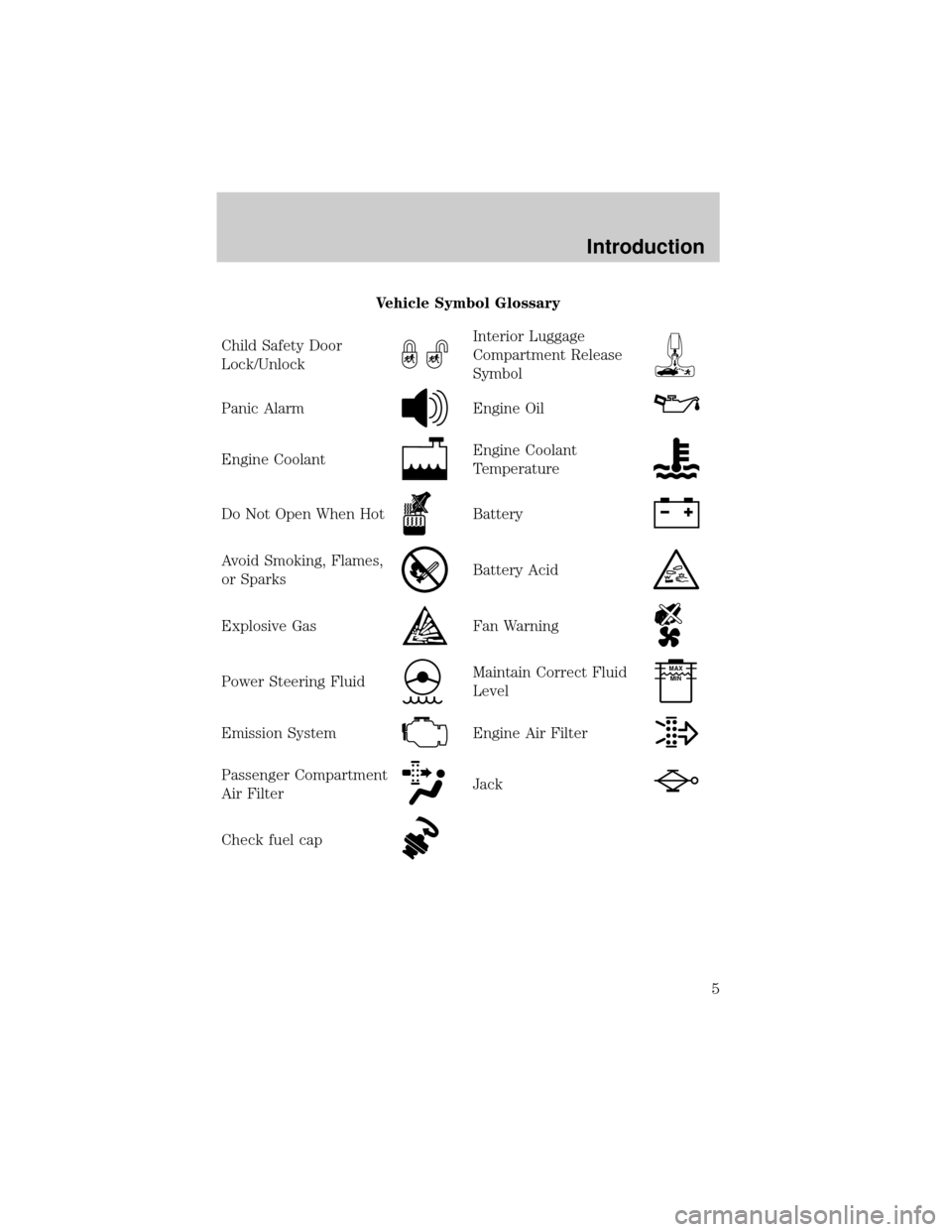
Vehicle Symbol Glossary
Child Safety Door
Lock/Unlock
Interior Luggage
Compartment Release
Symbol
Panic AlarmEngine Oil
Engine CoolantEngine Coolant
Temperature
Do Not Open When HotBattery
Avoid Smoking, Flames,
or SparksBattery Acid
Explosive GasFan Warning
Power Steering FluidMaintain Correct Fluid
LevelMAX
MIN
Emission SystemEngine Air Filter
Passenger Compartment
Air FilterJack
Check fuel cap
Introduction
5
Page 109 of 240

Hydraulic brake booster system (Hydromax)
The Hydromax systems receive fluid pressure from the power steering
pump to provide power assist during braking.
The Hydromax booster receives backup pressure from the reserve
system electric pump whenever the fluid in the power steering system is
not flowing. When the engine is OFF, the pump will turn on if the brake
pedal is applied, or if the ignition is turned to the ON position.
The sound of the pump operating may be heard by the driver, but this is
a normal characteristic of the system.
The reserve system provides reduced braking power, so the vehicle
should be operated under these conditions with caution, and only to seek
service repair and remove the vehicle from the roadway.
For Hydromax under normal operating conditions noise of the fluid
flowing through the booster may be heard whenever the brake is applied.
This condition is normal. Vehicle service is not required.
If braking performance or pedal response becomes very poor, even when
the pedal is strongly applied, this may indicate the presence of air in the
hydraulic system or fluid leakage. Stop the vehicle safely as soon as
possible and seek service immediately.
If the red BRAKE warning lamp in
the instrument cluster remains
illuminated after engine start up,
this indicates a system failure in the
master cylinder of the brake system.
Stop the vehicle safely as soon as possible and seek service immediately.
If the yellow BRAKE RESERVE
(E-motor) warning light remains on
while the engine is running, this
indicates inadequate hydraulic
booster pressure or reserve pump
system failure. Stop the vehicle safely as soon as possible and seek
service immediately.
!
BRAKE
BRAKE
Driving
109
Page 124 of 240
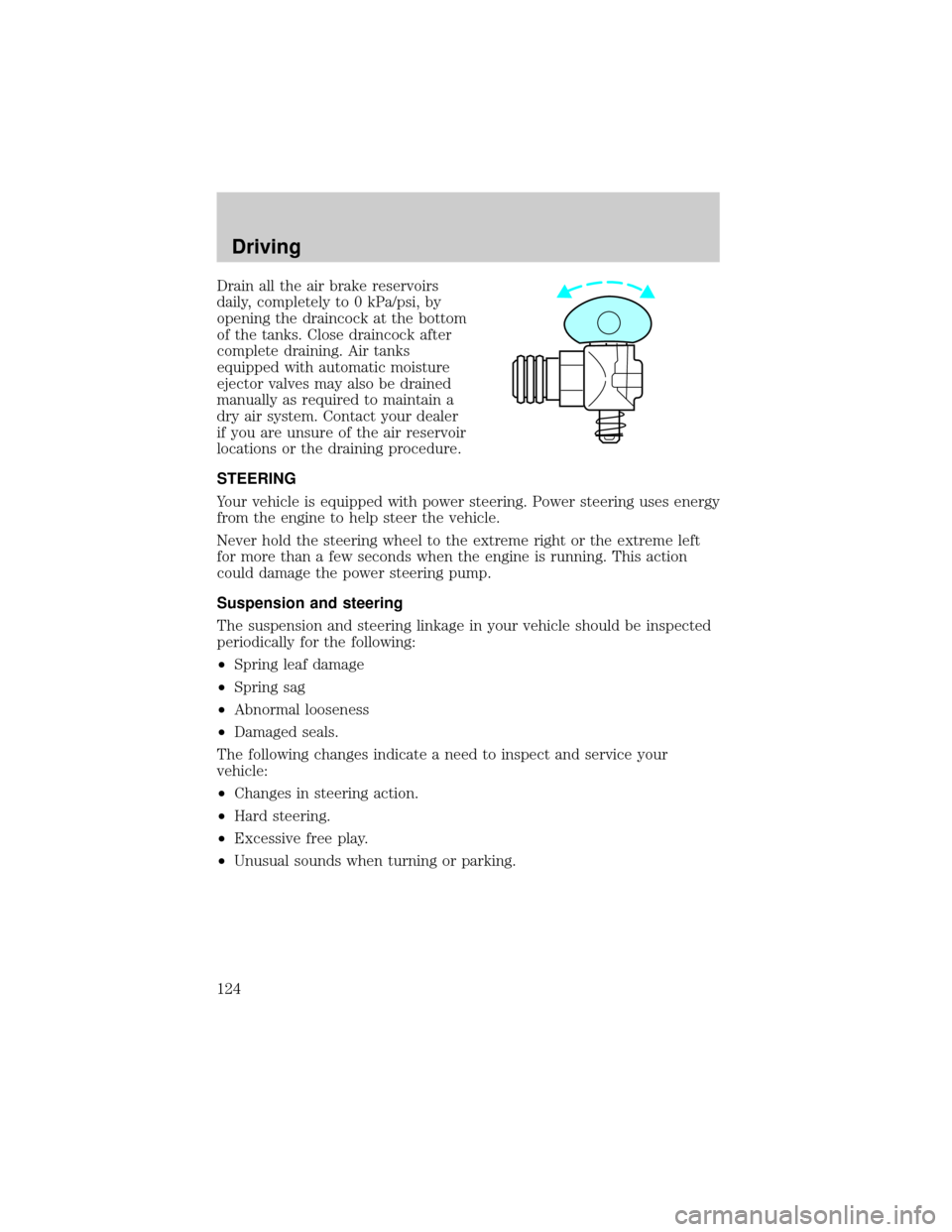
Drain all the air brake reservoirs
daily, completely to 0 kPa/psi, by
opening the draincock at the bottom
of the tanks. Close draincock after
complete draining. Air tanks
equipped with automatic moisture
ejector valves may also be drained
manually as required to maintain a
dry air system. Contact your dealer
if you are unsure of the air reservoir
locations or the draining procedure.
STEERING
Your vehicle is equipped with power steering. Power steering uses energy
from the engine to help steer the vehicle.
Never hold the steering wheel to the extreme right or the extreme left
for more than a few seconds when the engine is running. This action
could damage the power steering pump.
Suspension and steering
The suspension and steering linkage in your vehicle should be inspected
periodically for the following:
²Spring leaf damage
²Spring sag
²Abnormal looseness
²Damaged seals.
The following changes indicate a need to inspect and service your
vehicle:
²Changes in steering action.
²Hard steering.
²Excessive free play.
²Unusual sounds when turning or parking.
Driving
124
Page 125 of 240

If the steering wanders or pulls
This condition can be caused by any of the following conditions:
²Underinflated tire(s) on any wheel(s)
²Front end out of alignment
²Total vehicle out of alignment (i.e. rear axle[s] out of alignment with
front axle)
²Improper adjustment in the steering gear
²Vehicle overloaded or unevenly loaded
²High crosswinds
²High crown in center of road
²Components in steering linkage loose or worn
²Wheel bearings improperly adjusted
²Excessive lash in steering shaft or universal joints
If the vehicle steers hard
Hard steering can be caused by any of the following conditions:
²Underinflated tire(s) on any wheel(s)
²Vehicle overload
²Misalignment of the front tires
²Lack of lubricant in the front spindle bearings or linkage components
²Low oil level in the power steering system
²Broken or loose power steering pump direct drive connection
²Malfunctioning relief valve in power steering gear or steering pump
²Malfunctioning power steering pump
²Restriction in power steering lines
²Improperly set turn stops
²Air entrapped in power steering system fluid
AIR SUSPENSION SYSTEM (IF EQUIPPED)
The on-highway air suspension system is designed to provide a superior
ride, outstanding driver comfort while minimizing wear on the cab, frame
and payload.
The height control valve automatically keeps the vehicle at a constant
level due to load changes and uneven road surfaces.
Driving
125
Page 168 of 240

Adding and replacing engine coolant-Caterpillar 3126 B engine
Refer to the engine operator's manual for additional engine cooling
system information.
FAN CLUTCHES
Your vehicle's cooling system is equipped with a viscous variable speed
fan clutch.
²The fan clutch helps control cooling, increase performance, improve
fuel economy and reduce noise.
²The fan clutch is controlled by bimetallic spring sensors. Do not
tamper with these sensors as this may change their calibration or keep
the fan clutch from operating at all.
Stay clear of the fan/fan area while the engine is running or
possible personal injury may occur.
CHECKING AND ADDING POWER STEERING FLUID
Checking power steering fluid level
Check the power steering fluid level using the following procedure. Refer
to the scheduled maintenance guide for the recommended service
intervals. If adding fluid is necessary, use only MERCONtAT F.
1. Set the parking brake, shift into N
(Neutral) (automatic transmission)
or 1 (First) (manual transmission)
and turn the engine off.
2. Open the hood.
3. Clean the top of the power
steering fluid reservoir.
4. Remove the dipstick from the
reservoir and wipe the dipstick clean.
Maintenance and care
168
Page 169 of 240
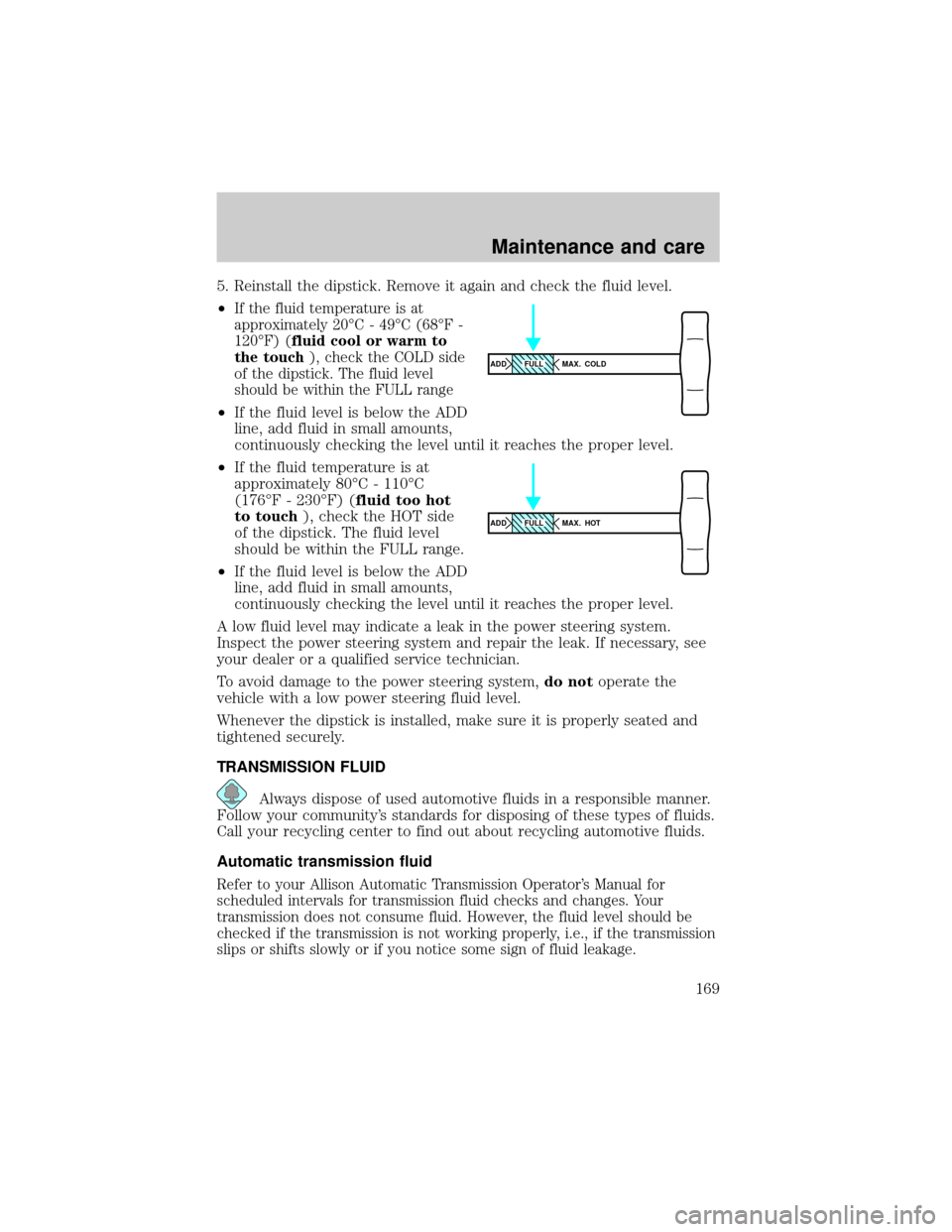
5. Reinstall the dipstick. Remove it again and check the fluid level.
²
If the fluid temperature is at
approximately 20ÉC - 49ÉC (68ÉF -
120ÉF) (fluid cool or warm to
the touch), check the COLD side
of the dipstick. The fluid level
should be within the FULL range
²If the fluid level is below the ADD
line, add fluid in small amounts,
continuously checking the level until it reaches the proper level.
²If the fluid temperature is at
approximately 80ÉC - 110ÉC
(176ÉF - 230ÉF) (fluid too hot
to touch), check the HOT side
of the dipstick. The fluid level
should be within the FULL range.
²If the fluid level is below the ADD
line, add fluid in small amounts,
continuously checking the level until it reaches the proper level.
A low fluid level may indicate a leak in the power steering system.
Inspect the power steering system and repair the leak. If necessary, see
your dealer or a qualified service technician.
To avoid damage to the power steering system,do notoperate the
vehicle with a low power steering fluid level.
Whenever the dipstick is installed, make sure it is properly seated and
tightened securely.
TRANSMISSION FLUID
Always dispose of used automotive fluids in a responsible manner.
Follow your community's standards for disposing of these types of fluids.
Call your recycling center to find out about recycling automotive fluids.
Automatic transmission fluid
Refer to your Allison Automatic Transmission Operator's Manual for
scheduled intervals for transmission fluid checks and changes. Your
transmission does not consume fluid. However, the fluid level should be
checked if the transmission is not working properly, i.e., if the transmission
slips or shifts slowly or if you notice some sign of fluid leakage.
ADD MAX. COLDFULL
ADD MAX. HOTFULL
Maintenance and care
169
Page 200 of 240
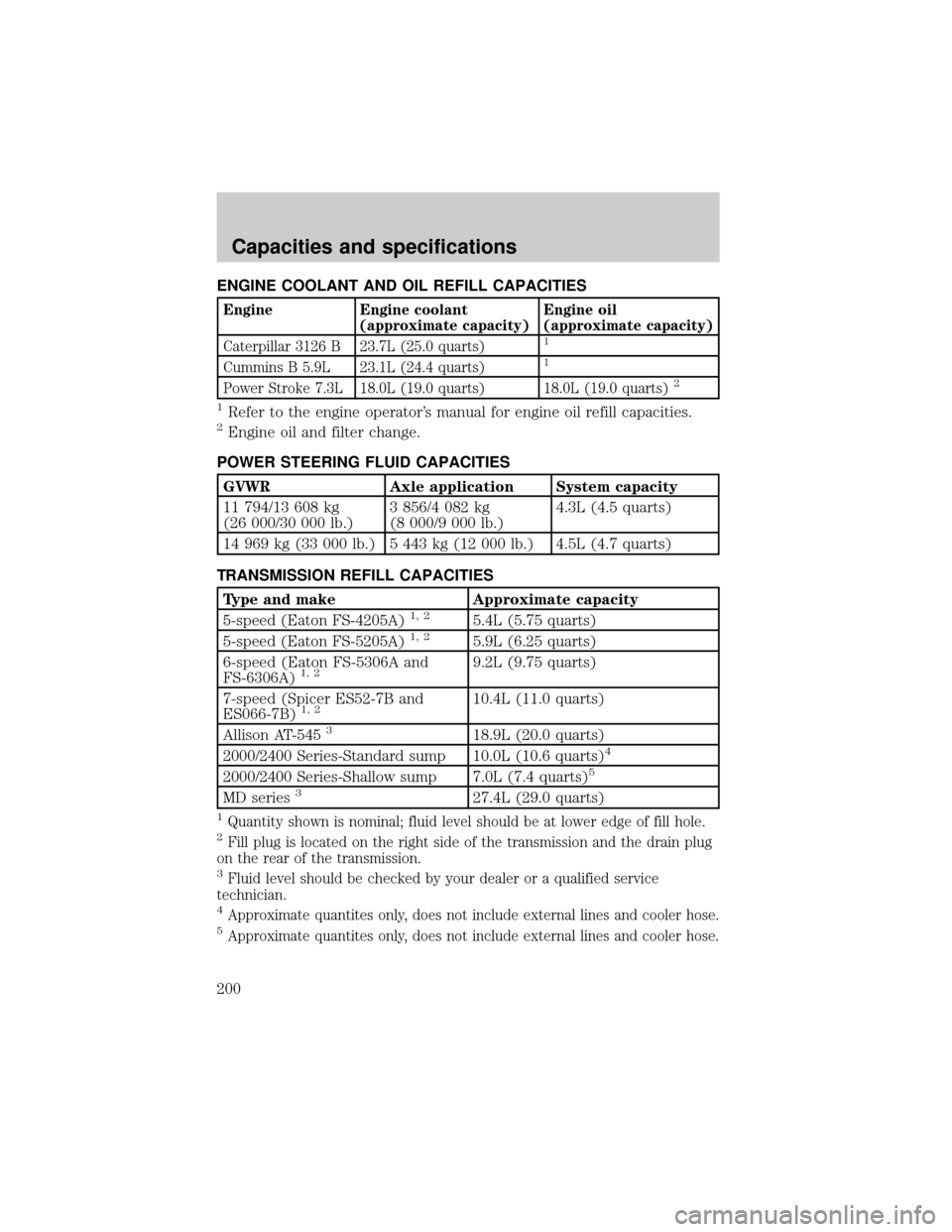
ENGINE COOLANT AND OIL REFILL CAPACITIES
Engine Engine coolant
(approximate capacity)Engine oil
(approximate capacity)
Caterpillar 3126 B 23.7L (25.0 quarts)
1
Cummins B 5.9L 23.1L (24.4 quarts)1
Power Stroke 7.3L 18.0L (19.0 quarts) 18.0L (19.0 quarts)2
1Refer to the engine operator's manual for engine oil refill capacities.2Engine oil and filter change.
POWER STEERING FLUID CAPACITIES
GVWR Axle application System capacity
11 794/13 608 kg
(26 000/30 000 lb.)3 856/4 082 kg
(8 000/9 000 lb.)4.3L (4.5 quarts)
14 969 kg (33 000 lb.) 5 443 kg (12 000 lb.) 4.5L (4.7 quarts)
TRANSMISSION REFILL CAPACITIES
Type and make Approximate capacity
5-speed (Eaton FS-4205A)1, 25.4L (5.75 quarts)
5-speed (Eaton FS-5205A)1, 25.9L (6.25 quarts)
6-speed (Eaton FS-5306A and
FS-6306A)
1, 29.2L (9.75 quarts)
7-speed (Spicer ES52-7B and
ES066-7B)
1, 210.4L (11.0 quarts)
Allison AT-545
318.9L (20.0 quarts)
2000/2400 Series-Standard sump 10.0L (10.6 quarts)4
2000/2400 Series-Shallow sump 7.0L (7.4 quarts)5
MD series327.4L (29.0 quarts)
1Quantity shown is nominal; fluid level should be at lower edge of fill hole.2Fill plug is located on the right side of the transmission and the drain plug
on the rear of the transmission.
3Fluid level should be checked by your dealer or a qualified service
technician.
4Approximate quantites only, does not include external lines and cooler hose.5Approximate quantites only, does not include external lines and cooler hose.
Capacities and specifications
200
Page 202 of 240
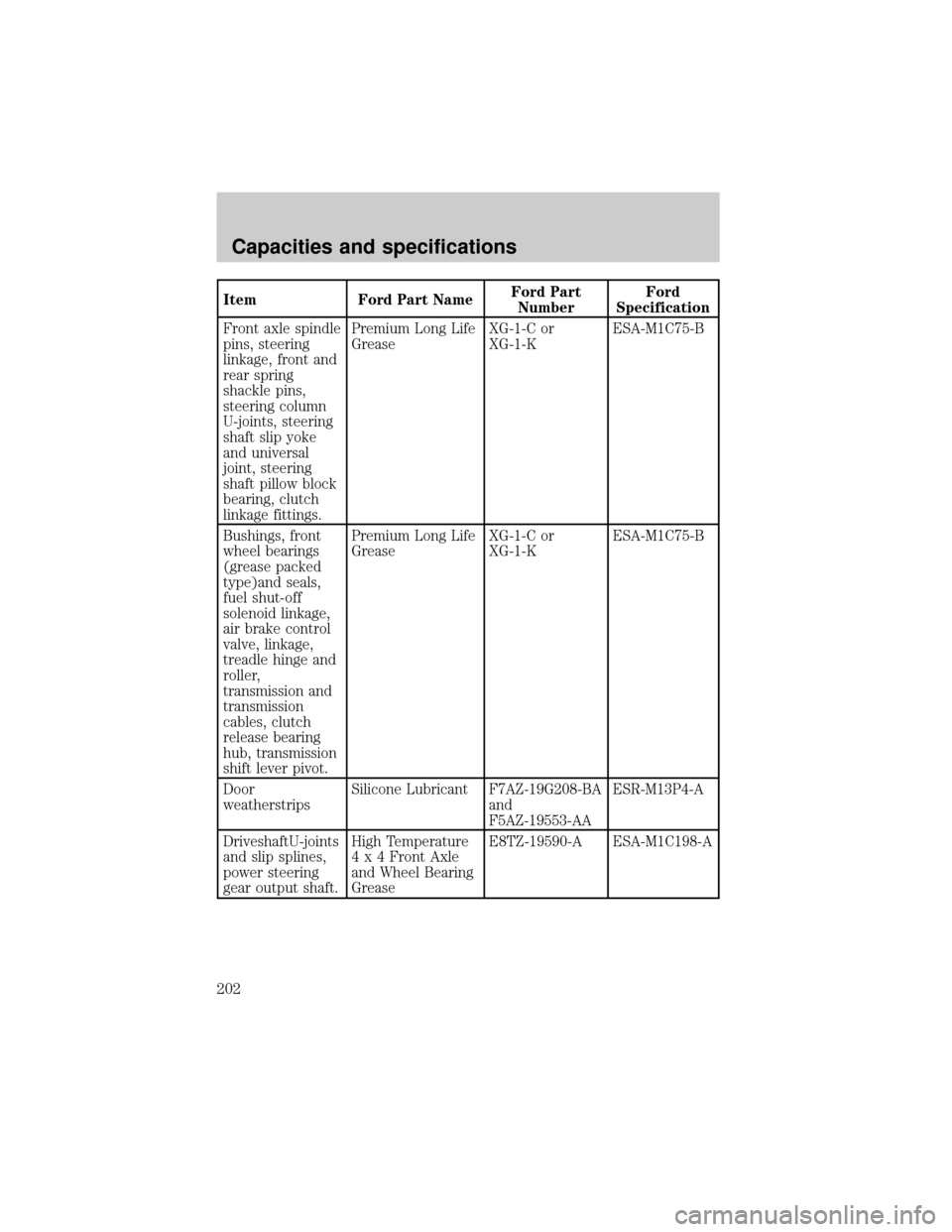
Item Ford Part NameFord Part
NumberFord
Specification
Front axle spindle
pins, steering
linkage, front and
rear spring
shackle pins,
steering column
U-joints, steering
shaft slip yoke
and universal
joint, steering
shaft pillow block
bearing, clutch
linkage fittings.Premium Long Life
GreaseXG-1-C or
XG-1-KESA-M1C75-B
Bushings, front
wheel bearings
(grease packed
type)and seals,
fuel shut-off
solenoid linkage,
air brake control
valve, linkage,
treadle hinge and
roller,
transmission and
transmission
cables, clutch
release bearing
hub, transmission
shift lever pivot.Premium Long Life
GreaseXG-1-C or
XG-1-KESA-M1C75-B
Door
weatherstripsSilicone Lubricant F7AZ-19G208-BA
and
F5AZ-19553-AAESR-M13P4-A
DriveshaftU-joints
and slip splines,
power steering
gear output shaft.High Temperature
4 x 4 Front Axle
and Wheel Bearing
GreaseE8TZ-19590-A ESA-M1C198-A
Capacities and specifications
202